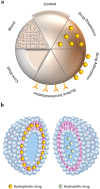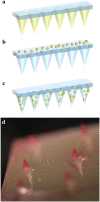Therapy of infected wounds: overcoming clinical challenges by advanced drug delivery systems
- PMID: 33611768
- PMCID: PMC8236057
- DOI: 10.1007/s13346-021-00932-7
Therapy of infected wounds: overcoming clinical challenges by advanced drug delivery systems
Abstract
In recent years, the incidence of infected wounds is steadily increasing, and so is the clinical as well as economic interest in effective therapies. These combine reduction of pathogen load in the wound with general wound management to facilitate the healing process. The success of current therapies is challenged by harsh conditions in the wound microenvironment, chronicity, and biofilm formation, thus impeding adequate concentrations of active antimicrobials at the site of infection. Inadequate dosing accuracy of systemically and topically applied antibiotics is prone to promote development of antibiotic resistance, while in the case of antiseptics, cytotoxicity is a major problem. Advanced drug delivery systems have the potential to enable the tailor-made application of antimicrobials to the side of action, resulting in an effective treatment with negligible side effects. This review provides a comprehensive overview of the current state of treatment options for the therapy of infected wounds. In this context, a special focus is set on delivery systems for antimicrobials ranging from semi-solid and liquid formulations over wound dressings to more advanced carriers such as nano-sized particulate systems, vesicular systems, electrospun fibers, and microneedles, which are discussed regarding their potential for effective therapy of wound infections. Further, established and novel models and analytical techniques for preclinical testing are introduced and a future perspective is provided.
Keywords: Antimicrobial resistance; Bacterial biofilm; Drug delivery systems; In vitro wound models; Wound dressings; Wound infection.
Conflict of interest statement
The authors declare that they have no conflict of interest.
Figures






Similar articles
-
Current State and Advances in Antimicrobial Strategies for Burn Wound Dressings: From Metal-Based Antimicrobials and Natural Bioactive Agents to Future Perspectives.Int J Mol Sci. 2025 May 5;26(9):4381. doi: 10.3390/ijms26094381. Int J Mol Sci. 2025. PMID: 40362617 Free PMC article. Review.
-
DEVELOPMENT OF A NEXT-GENERATION ANTIMICROBIAL WOUND DRESSING.Acta Med Croatica. 2016 Mar;70(1):49-56. Acta Med Croatica. 2016. PMID: 27220190
-
Recent advancements in cellulose-based biomaterials for management of infected wounds.Expert Opin Drug Deliv. 2021 Nov;18(11):1741-1760. doi: 10.1080/17425247.2021.1989407. Epub 2021 Oct 12. Expert Opin Drug Deliv. 2021. PMID: 34605347 Review.
-
Multispecies biofilm in an artificial wound bed--A novel model for in vitro assessment of solid antimicrobial dressings.J Microbiol Methods. 2014 Aug;103:18-24. doi: 10.1016/j.mimet.2014.05.008. Epub 2014 May 28. J Microbiol Methods. 2014. PMID: 24880129
-
Multifunctional Antimicrobial Nanofiber Dressings Containing ε-Polylysine for the Eradication of Bacterial Bioburden and Promotion of Wound Healing in Critically Colonized Wounds.ACS Appl Mater Interfaces. 2020 Apr 8;12(14):15989-16005. doi: 10.1021/acsami.9b21683. Epub 2020 Mar 27. ACS Appl Mater Interfaces. 2020. PMID: 32172559
Cited by
-
Research frontiers and hotspots in bacterial biofilm wound therapy: bibliometric and visual analysis for 2012-2022.Ann Med Surg (Lond). 2023 Sep 14;85(11):5538-5549. doi: 10.1097/MS9.0000000000001321. eCollection 2023 Nov. Ann Med Surg (Lond). 2023. PMID: 37915709 Free PMC article.
-
Antibacterial smart hydrogels: New hope for infectious wound management.Mater Today Bio. 2022 Nov 19;17:100499. doi: 10.1016/j.mtbio.2022.100499. eCollection 2022 Dec 15. Mater Today Bio. 2022. PMID: 36466959 Free PMC article. Review.
-
The chronic wound milieu changes essential oils' antibiofilm activity-an in vitro and larval model study.Sci Rep. 2024 Jan 26;14(1):2218. doi: 10.1038/s41598-024-52424-6. Sci Rep. 2024. PMID: 38278929 Free PMC article.
-
Acceleration of Healing in Full-Thickness Wound by Chitosan-Binding bFGF and Antimicrobial Peptide Modification Chitosan Membrane.Front Bioeng Biotechnol. 2022 Apr 25;10:878588. doi: 10.3389/fbioe.2022.878588. eCollection 2022. Front Bioeng Biotechnol. 2022. PMID: 35547167 Free PMC article.
-
The Use of Proteins, Lipids, and Carbohydrates in the Management of Wounds.Molecules. 2023 Feb 7;28(4):1580. doi: 10.3390/molecules28041580. Molecules. 2023. PMID: 36838568 Free PMC article. Review.
References
Publication types
MeSH terms
Substances
LinkOut - more resources
Full Text Sources
Other Literature Sources

